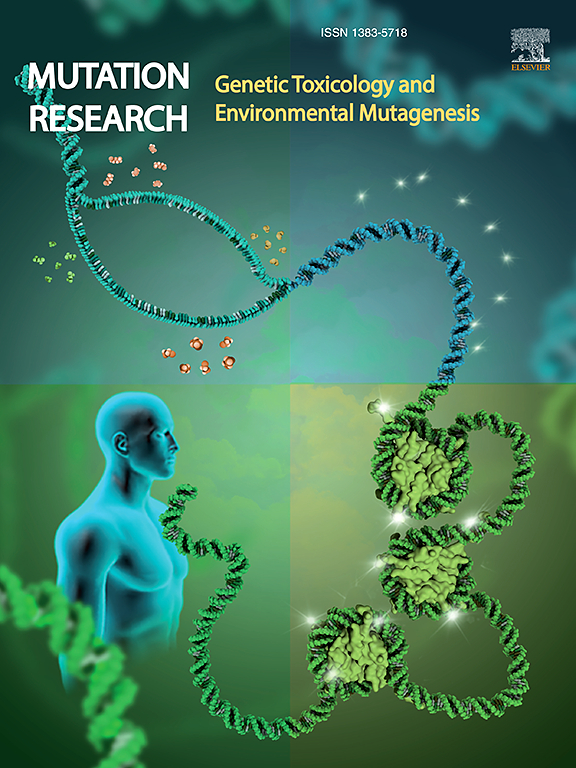土耳其伊兹密尔湾贻贝(Mytilus galloprovincialis L.)对污染的DNA损伤和氧化应激反应:季节评价
IF 2.5
4区 医学
Q3 BIOTECHNOLOGY & APPLIED MICROBIOLOGY
Mutation research. Genetic toxicology and environmental mutagenesis
Pub Date : 2025-03-23
DOI:10.1016/j.mrgentox.2025.503866
引用次数: 0
摘要
本研究通过对爱琴海受到不同人为影响的土耳其伊兹密尔湾贻贝取样,评估了DNA损伤与重金属污染之间的关系。在伊兹密尔湾4个不同监测站,选取加洛毛霉作为生物指示生物,测定土壤重金属含量、SOD、CAT、TBARS水平及DNA损伤检测。与春季相比,夏季在阿尔桑卡克采集的贻贝的消化腺组织中检测到的所有重金属都显着增加。其中,夏季采集的贻贝鳃和消化腺锌含量分别为22.411和40.447 μg/g。根据MPI值,确定了Urla的显著差异,并计算了鳃组织的最高蓄积量。除乌拉市外,夏季各试验点贻贝鳃和腺体SOD和CAT酶活性均高于春季。此外,与春季样本相比,夏季Inciralti和Urla站贻贝鳃和性腺组织中的TBARS水平较高。所有站点贻贝血细胞的DNA损伤分类根据Comet测定法确定。结果表明,夏季采集贻贝血细胞中彗尾DNA含量较春季显著降低。此外,除Alsancak外,所有站点的遗传损害指数在夏季都比春季下降。在Alsancak和inciralti采集的贻贝中,重金属污染与DNA损伤呈正相关(r = 0.734),而在Pasaport和Urla采集的贻贝中,两个季节重金属污染与DNA损伤呈显著相关(r = 0.999)。该研究表明,伊兹密尔湾贻贝重金属污染仍然是该地区的环境问题。即使在低重金属污染地区,DNA损伤也是一种适宜的遗传毒性评价生物标志物。本文章由计算机程序翻译,如有差异,请以英文原文为准。
DNA damage and oxidative stress responses to pollution of Mytilus galloprovincialis L. from the Izmir Bay (Turkey): Seasonal evaluation
In the current study, the relationship between DNA damage and heavy metal pollutions was evaluated by sampling mussels from Izmir Bay (Turkey), which has different anthropogenic impacts in the Aegean Sea. M. galloprovincialis was selected as a bioindicator organism to determine the heavy metal amounts, SOD, CAT, TBARS levels and to detect the DNA damage in 4 different stations of Izmir Bay. A significant increase was detected in all heavy metals in the digestive gland tissue of the mussels collected from the Alsancak in summer compared to spring. Especially, Zn levels of gills and digestive glands of mussels collected from Alsancak in summer were detected 22.411 and 40.447 μg/g, respectively. According to MPI values, significant differences were determined in Urla and the highest accumulation was calculated in gill tissue. The activities of SOD and CAT enzymes were found at a very high level in mussel gills and glands at all stations except Urla in summer compared to them in spring. Additionally, TBARS levels were higher in mussel gills and gonad tissues at Inciralti and Urla stations in summer compared to spring samples. DNA damage classification in mussel hemocytes from all stations was identified according to the Comet assay. The test results showed that a statistically significant decrease in DNA% in comet tails in hemocytes of mussels collected from all stations in Summer was found compared to them in Spring. Also, at all stations except Alsancak, the genetic damage index decreased in summer compared to spring. While a positive correlation was detected between heavy metal pollution and DNA damage in mussels taken from Alsancak and Inciraltı (r = 0.734), a significant correlation was detected in Pasaport and Urla in both seasons (r = 0.999). This study indicates that heavy metal contaminations in the mussels of Izmir Bay are still an environmental problem on this area. DNA damage is an appropriate biomarker for genotoxicity evaluation even in low heavy metal contaminated areas.
求助全文
通过发布文献求助,成功后即可免费获取论文全文。
去求助
来源期刊
CiteScore
3.80
自引率
5.30%
发文量
84
审稿时长
105 days
期刊介绍:
Mutation Research - Genetic Toxicology and Environmental Mutagenesis (MRGTEM) publishes papers advancing knowledge in the field of genetic toxicology. Papers are welcomed in the following areas:
New developments in genotoxicity testing of chemical agents (e.g. improvements in methodology of assay systems and interpretation of results).
Alternatives to and refinement of the use of animals in genotoxicity testing.
Nano-genotoxicology, the study of genotoxicity hazards and risks related to novel man-made nanomaterials.
Studies of epigenetic changes in relation to genotoxic effects.
The use of structure-activity relationships in predicting genotoxic effects.
The isolation and chemical characterization of novel environmental mutagens.
The measurement of genotoxic effects in human populations, when accompanied by quantitative measurements of environmental or occupational exposures.
The application of novel technologies for assessing the hazard and risks associated with genotoxic substances (e.g. OMICS or other high-throughput approaches to genotoxicity testing).
MRGTEM is now accepting submissions for a new section of the journal: Current Topics in Genotoxicity Testing, that will be dedicated to the discussion of current issues relating to design, interpretation and strategic use of genotoxicity tests. This section is envisaged to include discussions relating to the development of new international testing guidelines, but also to wider topics in the field. The evaluation of contrasting or opposing viewpoints is welcomed as long as the presentation is in accordance with the journal''s aims, scope, and policies.

 求助内容:
求助内容: 应助结果提醒方式:
应助结果提醒方式:


